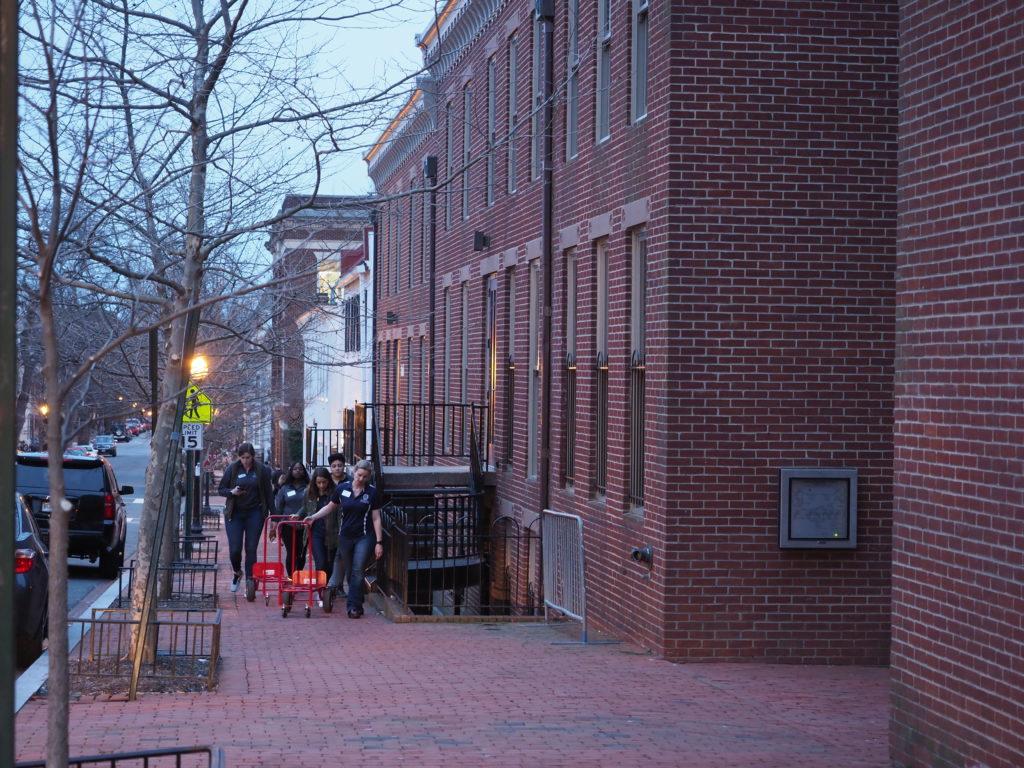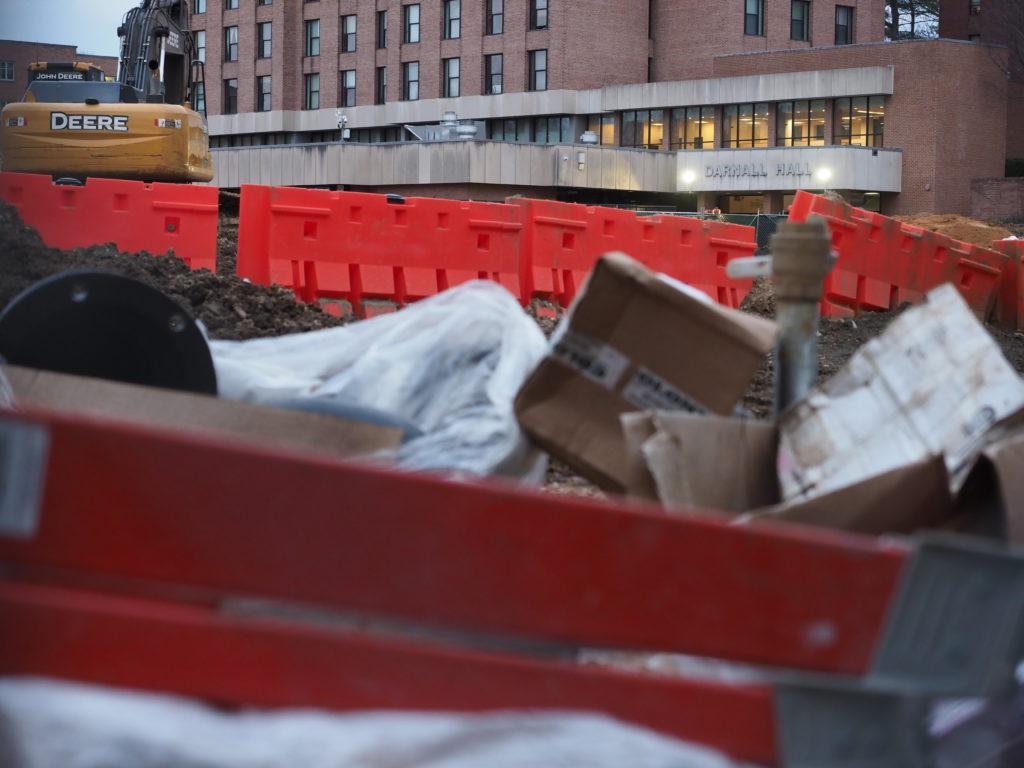When students from top-floor apartments in Alumni Square were relocated to the Georgetown University Hotel and Conference Center last week, administrators assured them that they were acting with an abundance of caution.
However, university officials failed to act on water damage in Alumni Square they observed as early as last summer, according to an Alumni Square resident who had several conversations with senior university officials.
The Alumni Square relocation has intensified scrutiny of Georgetown’s maintenance and renovation process, exacerbating concerns about delayed responses to urgent safety issues, poor communication and negligence from university administrators.
These challenges are not only frustrating, but life-threatening for students like former Alumni Square resident Sean Fulmer (SFS ’20). (Full disclosure: Fulmer is a staff writer for The Hoya).
“I wasn’t told directly, but my roommate was [told] by a contractor that if we had been in the room when the ceiling collapsed that we would have died,” Fulmer said.
A Feb. 11 notice gave 84 residents of top-floor apartments in Alumni Square four days to find off-campus housing or relocate to the Georgetown Hotel and Conference Center for the rest of the semester after structural engineers expressed concerns about moisture and pressure on Alumni Square roofs, according to a university webpage.
A university official may have known about water damage on roofs of Alumni Square apartments weeks before the first apartment in Alumni Square was ever inspected, Fulmer learned in conversations with Vice President for Student Affairs Todd Olson and Chief Operating Officer Geoff Chatas. University officials did not comment on Fulmer’s claim.
Humeyra Selcukbiricik (COL ’20), who recounted the multiple health risks she encountered as a resident of campus housing in a Feb. 20 op-ed in The Hoya, is among the relocated students from Alumni Square, who feel neglected despite recent efforts to invest in deferred maintenance.

“We were just notified last minute as if we are objects that need to be moved to clear out the way,” Selcukbiricik said in an interview with The Hoya.
Delayed Reaction
Georgetown’s delay in addressing Alumni Square roof damage reflects student criticisms about the responsiveness of Georgetown’s work order system.
Inspections on the Alumni Square rooftops began after a maintenance inquiry in October 2018, according to a university webpage.
Fulmer and his roommates initiated that first inquiry for their top-floor apartment with a series of six phone calls and two work requests to the Office of Planning and Facilities Management, spanning from Sept. 10 to Oct. 2.
Within that three-week span last fall, facilities crews inspected his apartment’s collapsing roof three times, but the first two teams took no action to address the issue, according to Fulmer.
“The first time, they told us the carpentry department would be called and they’d come to work on it, and they never showed up,” Fulmer said. “The second time, they told us it was very serious and then never came back again.”
Understaffing and low wages for facilities workers are key factors behind delayed work requests, according to Chad Gasman (COL ’20), a residential assistant for McCarthy Hall.
“It’s not the facilities workers who are at fault, because they honestly try their best and they do the best they can with the amount of energy they’re given and the wages they’re given,” Gasman said in an interview with The Hoya. “It’s the fact that they’re not paid enough and the management isn’t doing enough to support them.”
Vice President of Planning and Facilities Management Benjamin Kuo did not answer questions regarding causes of delayed responses or whether facilities tracked response times to work orders. Instead, he referred students to the facilities website and encouraged feedback.
“We appreciate all feedback and from faculty, staff, students, parents, and others and take their input very seriously when considering how to improve our service to the community,” Kuo wrote in an email to The Hoya.
Unprepared For Emergency
When dorms pose an immediate health or safety threat to residents, emergency housing may not be guaranteed. When a third facilities crew arrived at Fulmer’s apartment Oct. 2, they told Fulmer and his roommates their ceiling was about to collapse and they needed to evacuate that night, according to Fulmer.
“They didn’t provide us housing that night, they told us we had to find somebody’s couch to live on,” Fulmer said.
RAs do not have information about procedures for emergency housing in cases of immediate evacuation like Fulmer’s, according to Gasman.
“RAs are definitely kept in the dark about emergency housing,” Gasman said. “I don’t know if that’s on Res. Living or facilities or who is in charge of it. But I definitely think RAs have no idea what’s going on with emergency housing.”
Olson did not answer questions on whether Residential Living maintained spaces for emergency housing or if the Alumni Square relocation would reduce the availability of emergency housing.
Instead, Olson referenced the medical housing process of the Academic Resource Center, which relocates students for general safety and health concerns.
“In any case where students would have to be relocated due to safety or health concerns, we would take action to make housing accommodations while minimizing disruption as much as possible,” Olson wrote.
After their evacuation, Fulmer and his roommates stayed for two nights at the Key Bridge Marriott Hotel in Rosslyn, Va., before the university placed them in a Village A apartment.
Soon after Fulmer and his roommates moved in, however, the former residents of their new apartment warned them about the living space’s pre-existing hazards.
“The people previously living there knocked on our door and told us they had to be moved out because of horrific mold problems,” Fulmer said.
Fulmer and his roommates called facilities to measure the humidity in the apartment and ensure the mold had been dealt with, but Fulmer heard that the humidity standard used by facilities might not comply with an advisory from the Centers for Disease Control.
“With the girls who lived in that Vil. A before us, they came in and tested the humidity and said that that level was fine, but it was above what the CDC says is safe,” Fulmer said. “Why are they saying it’s okay if the CDC says it’s not?”

The CDC website states that indoor humidity levels should not exceed 50 percent. In an Oct. 18 op-ed in The Hoya, Luke Duffner (SFS ’20) wrote that facilities workers had approved of the relative humidity level in his apartment when it registered at 57 percent. After mold reports more than doubled last fall, at least one student contracted bronchitis from exposure to black mold in her dorm, leading to two emergency room trips.
Kuo did not directly respond when asked what standards facilities workers or hired contractors use to gauge the threat posed by mold, but instead described the process completed by Eastern Research Group, a contractor hired last fall to assist with Georgetown’s mold problem.
“They conducted visual inspections and measured air conditions in buildings with high reports of moisture and mold,” Kuo wrote in an email to The Hoya. “In areas where apparent mold growth or other issues were identified, Facilities Management was notified and the required cleaning was completed promptly.”
Nancy Cave, a parent of a Georgetown freshman, sent an email about air quality concerns in her son’s dorm to Gregory Simmons, associate vice president of facilities operations, on Jan. 2. Nine days later, she received a reply from Simmons promising to review the situation. Cave followed up in three more emails over the next four weeks, but received no reply until a phone call from Simmons on Feb. 12.
During that phone call, Simmons apologized for the late response and said cleaning efforts and air quality tests had been completed in her son’s dorm. When Cave asked for test reports from her son’s dorm, Simmons said those reports were not public, according to Cave.
“He tried to assure me that my son’s room is safe,” Cave wrote in an email to The Hoya. “I asked for the air report and he said it was not his call to release it to me or make it public and that there was a committee above him that made the call not to release the reports.”
Simmons did not comment on which committee bans the publication of air quality reports or the reason why reports are not public.
“After any tests are performed, the university thoroughly reviews the findings and takes appropriate actions to maintain the safety and well-being of community members,” a university spokesperson wrote in an email to The Hoya.
Unreliable Communication
After Fulmer and his roommates were relocated to their Village A apartment, they had multiple conversations with Olson and Chatas, including a dinner with Chatas at The Tombs, according to Fulmer.
Through those conversations, Fulmer and his roommates learned that an official from facilities had noticed water damage on Alumni Square rooftops several weeks before their apartment was inspected in September, but had failed to take any action.
“My roommates and I were informed that an official from Georgetown Facilities had seen the water damage weeks before on the roof and did not act on that observation,” Fulmer wrote in an email to The Hoya. “It was heavily implied in a later conversation with university officials that whoever was responsible for that was actually no longer with Georgetown. However, it is unclear whether Georgetown actually followed through on that, as the official is still listed on their website.”
The university did not comment on Fulmer’s statement and declined to name the university official mentioned by Fulmer. Student conversations with senior administrators to discuss concerns are not uncommon, according to a university spokesperson.
“Senior leaders from across the university meet with students to gather feedback and discuss how to enhance their experiences at Georgetown,” a university spokesperson wrote in an email to The Hoya.
While the university claims to communicate with students, Selcukbiricik, an international student, felt unprepared to grapple with the challenges of campus housing.
“I had no idea about what I was expecting, I just toured the campus once during the pre-orientation,” Selcukbiricik said. “I wish I had known I was going to sleep with rats for the next two years.”




















Tiffany • Feb 22, 2019 at 2:25 pm
In November 2018, the valve in the upstairs toilet of Vil A G104 broke, leaking a significant amount of water through the upstairs floor to the downstairs ceiling.
My roommates and I were not told to evacuate, but voluntarily chose to stay over at our friends’ houses, so we did not have to sleep with soaked carpers and industrial-sized fans in our apartment.
When we had returned the following morning, the ceiling of our ground floor had collapsed, with debris and a large metal rod on the floor. Surely, had we been downstairs and had the ceiling fall quickly, we would have been injured. Unlike the residents in the article, we were not even warned of the likelihood of a ceiling collapse.
The open ceiling exposed a combination of black and brown and yellow insulation, yellow showing new and dry insulation and the black showing moldy insulation.
Thankfully at this point, we were given housing in the hotel. However, the lack of warning about the risk of our ceiling collapsing, the black moldy insulation that could not have grown so moldy overnight, and the fact that we later found out that this apartment had a history (at least a year) of leaks and water issues, is highly concerning.